Jan 5, 2021
Boat Lift Styles
In Wisconsin waters, there are (5) different boat lift styles generally used. The (5) styles include:
- Cantilever,
- Vertical,
- Hydraulic,
- Floating, and
- Elevator boat lifts.
Different conditions require different boat lifts.
Cantilever Lift
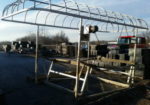
Cantilever Boat Lift Style
If you are on an inland lake or river where the water depth does not fluctuate more than 12″ throughout the boating season and wave action does not exceed 6″, a cantilever lift is generally suitable for you.
Cantilever lifts requires about 12″ of water plus the draft of your boat to operate. The lifting rack requires that depth of water due to the shape of the frames.
At first glance, that seems deep enough for most boats, but you still have to allow enough water above the rack to float your boat.
The real limitation of a cantilever lift is the total lifting height. If a river rises, especially after a heavy rainstorm, a boat can easily float off the lift. The boat is not up high enough to prevent the water from washing it away. Who knows how far it will travel before it hits something?
The normal lifting range is between 40″ and 48″. Remember, the rack starts at 12″ plus the draft of your boat, so you are usually less than 12″ above the water at its highest point.
Vertical Lift
On any large body of water, a vertical lift is the recommended lift for most people. Vertical lifts do a better job of protecting your boat from waves.
Some vertical lifts require about 6″-10″ of water plus the draft of the boat. As an example, ShoreMaster vertical boat lifts require only 6″ of water (plus the draft of your boat). Given the same conditions, you have already gained 6″ with this one feature alone.
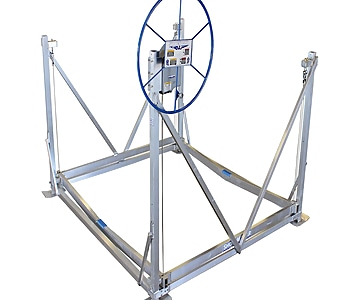
Vertical Boat Lift Style
Now, add the total lifting height of 66″ for a ShoreMaster vertical lift, and you gained a minimum of 18 or more inches of protection vs. a cantilever lift.
Your most significant protection comes from the lifting height. Don’t forget about the strength of the lift frame and the gauge of the material used. ONLY the ShoreMaster boat lift has welded side frames with heavy-duty square or rectangular frames for more strength.
Other brands require several packages of bolts and nuts to assemble the frames. Eventually, the holes for the bolts enlarge, and the frames begin to sway. The solid welded frame is a real advantage at this time. A minimal number of bolts are needed.
Can a lift raise a boat TOO high?
Strange as it may seem, it is possible to go too high. How? When the frames are not strong enough to handle the leverage of the weight from the boat.
At least one brand does lift higher than a ShoreMaster lift, but they failed to use welded frames for the additional strength it needs.
If you can imagine the forces acting against the frames in a storm when you have thousands of pounds suspended in the air with only simple bolts to hold them together. The higher the boat is, the greater the leverage on the frames.
Their leg wall thickness is not heavy enough to handle the forces acting against it. Green Bay produces more than 4′ high waves, and the waves frequently strike against the bottom of a boat, adding to the leverage problems.
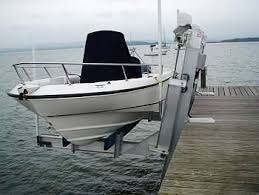
Elevator Boat Lift Style
Elevator Lift
Used with permanent pier installations, Elevator Lifts are a great combination. They raise the boat from the side, making access to the lift very easy.
Narrow channels and areas experiencing large fluctuations in water depth or hurricanes require elevator lifts.
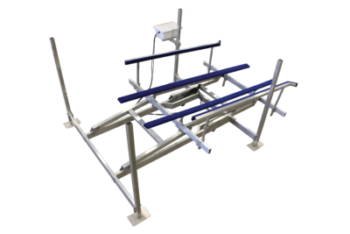
Hydraulic Boat Lifts Style
Hydraulic Boat Lift
A hydraulic lift generally lifts the highest – up to 6′ high in some cases. This height, along with the wide stance of the base, gives excellent protection for your boat. The hydraulic lift handles high waves and water surges during storms also.
These D.C. operated units are:
- Quiet:
- Smooth operating;
- Solar-powered;
- Wireless remote-controlled (There are no wheels to contend with.)
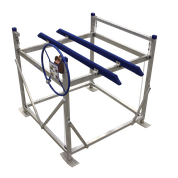
Vertical PWC Boat Lift
Vertical PWC Lift
Jet Ski lifts come in 3 styles: Vertical, Cantilever, and Floating.
The vertical PWC lifts allow you to get into shallow water and raise your boat higher than the cantilever type. They operate in the same fashion as a standard vertical boat lift and provide more protection for your PWC.
The PWC cantilever lift works fine on small lakes and rivers that do not fluctuate in depth or have high waves.
SHOREPORT
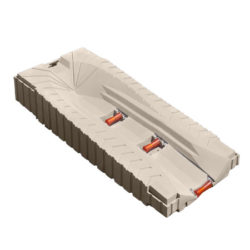
ShorePort PWC Boat Lift Style
The floating lifts (ShorePort) are excellent on rivers that fluctuate a lot in depth or inland lakes. These are very simple to use and require very little water to operate. The floating lift has no maintenance and you simply drive up onto the floating unit. No wheel cranking involved.
Wave action above 12” is not recommended for this type of “lift”. Combine a floating dock with the PWC floating lift and you have the perfect combination for a lake or river that fluctuates during the season but does not have large wave action.
Caution – when using any PWC lift – If you have a sand or small rock bottom near the shore use caution when approaching the lift. Sand and small stones can be sucked into the intake and destroy your motor.
For more information see also: www.wisconsinpws.com/boat-lift-size-correct-one/ and https://wisconsinpws.com/boat-lift-selection/
Where is Pier & Waterfront Solutions?
Located at 7325 St. Hwy 57, it’s 3 miles south of Sturgeon Bay and 1 mile PAST the intersection of Cty MM (heading north). Look on the right at the intersection of Idlewild Road and Hwy 57.
ARE WE OPEN?
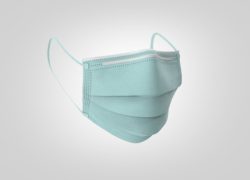
Please use face masks
Pier & Waterfront Solutions remains “open” year-round.
The virus continues to spread. PWS is conducting as much business as possible by email, text, or phone.
Site visits continue as usual. When in-person contacts are necessary, we follow “social distancing” guidelines as closely as possible.
Our display yard is OPEN 24-7
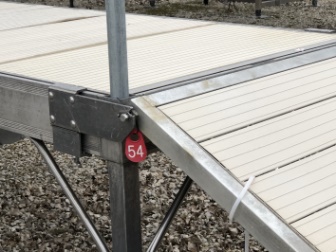
Red Tag
PWS‘s display yard is always open for you to examine at your leisure. All displays available for sale have a numbered, red tag on them. If you want more information or pricing, please reference that number when you inquire.
We provide estimates and quotes by email to make the process faster, safer, and paperless.
What can YOU do?
Please conduct as much business as possible via emails, messaging, and phones. When you see our staff and crews on-site, please practice “social distancing.”
Call, message, or email us with any questions.
Thank you for allowing us to work with you safely.
Let’s all stay safe!
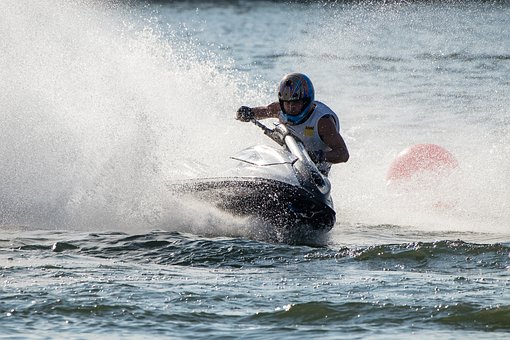
Jul 23, 2019
JET SKIS and THE LAW
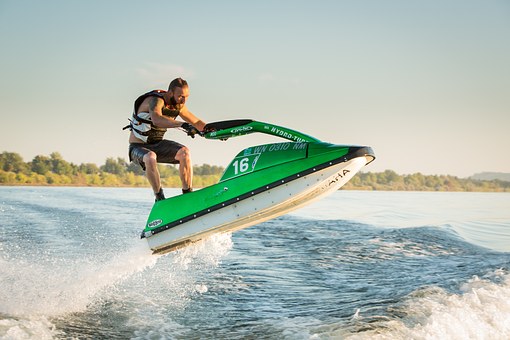
Stand-up PWC
State & Federal law has a lot to say about how you operate your Jet Ski.
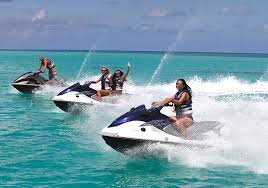
Keep 100 feet apart
Many people don’t realize there are legal ways and some NOT so legal ways to operate a PWC or jet ski.
Beyond the usual title and registration that everyone expects, there are specific laws that apply to PWC’s.
Who can operate a jet ski?
In Wisconsin, a person younger than 12 years of age, may not operate a PWC or jet ski.
12-15 years olds may operate a pwc ONLY If they have completed a boating safety course. The Wisconsin DNR must accept the course. Sorry, you can’t substitute parental supervision for this course.
A person at least 16 years old may operate a PWC only if they have completed an accepted boating safety course.
Were you born before Jan 1, 1989?
You are exempt from the course requirement.
No one under 16 years old may rent or lease a PWC.
Remember if you have taken the proper courses, you must carry a copy of the certificate with you and make it available to law enforcement officers when requested.
In addition to the U.S. Coast Guard, Wisconsin conservation wardens, county sheriffs, and municipal police enforce the laws.
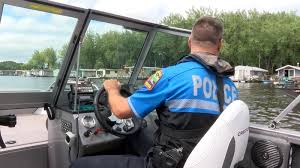
Boat Safety Rule #3- Don’t get a visit from him
Just like driving a vehicle, it is illegal to:
- refuse to follow the instruction of a law enforcement officer.
- A pwc operator must slow to “no-wake” or “slow” and give way to a patrol boat if it’s emergency lights are on or if they signal you to stop.
- You must stop when requested or signaled by a law enforcement officer or patrol boat.
- Furthermore, you must reduce speed to “slow” or “no-wake” and stay at least 100 feet from a patrol boat with its emergency lights activated. It’s similar to pulling into another lane when you see an emergency vehicle on a roadway.
You must have the legally required equipment on board at all times including:
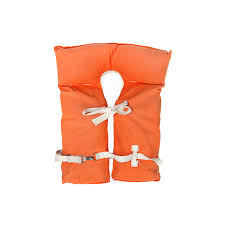
Boat Safety Rule #1- Everyone needs one
- PFD (personal flotation device or life jackets) even on canoes and kayaks.
- Kids under 13 must WEAR their PDF while underway on a pwc on federally controlled waters.
- EVERY person on a pwc MUST wear an approved PDF.
- You must wear the proper size PDF, and it must be in good and serviceable condition. No tears, rips, broken straps, or snaps.
Do I need a sound-producing device (Horn) on a PWC?
No! UNLESS you are on federally controlled waters like Lake Michigan.
Are we done? Not Really!
It is against the law to operate a vessel in a negligent or reckless manner such as in a manner that causes danger to life or limb.
Here are some examples:
Operating a vessel within 100 feet of the shoreline, a raft or pier at speeds higher than “no-wake” or “Slow.”
Jumping the wake of another vessel that is towing someone;
Operating a pwc within an area which is marked off for swimming;
Weaving your craft through congested waterways;
Causing hazardous wave or wake conditions while passing another vessel;
Steering toward another object or person and swerving at the last moment; or chasing, harassing or disturbing wildlife.
Overloading your vessel
If you have a pwc rated for two people, that is the maximum number you can have on it at any time regardless of weight or age.
These are just some of the laws you must follow.
Think of operating a vessel like you would a car. If it’s not legal in a car or truck, don’t try it on the water. Example – Do NOT drink and drive!!
Visit the DNR website at www.dnr.wi.gov and enter “boat safety” to find acceptable boating courses. Also, look for https://dnr.wi.gov/files/pdf/pubs/le/le0301.pdf
To read part one of this series go to https://wisconsinpws.com/pwc-jet-ski-users-guide
Keep us all safe, and we’ll all enjoy the water more on a PWC.
Do you have a friend that might be interested in this post? Please forward it to them.
Pier & Waterfront Solutions
PWS is located at 7325 St. Hwy 57. That’s 1 mile North of County MM (Hwy 42) and 3 miles south of Sturgeon Bay at the Idlewild Road intersection. Or – for more information, you can call Jerry @ 920-493-4404.
May 22, 2018
PWC Jet Ski Lift – Part 2
A PWC Lift is used to protect your Jet ski or PWC from the elements.
In Part 1 of this series we discussed cantilevered and Vertical Lifts. In part 2, we examine two additional PWC lift options for protecting your jet ski.
The Vertical Jet Ski Lift is by far the most popular means of protecting your jet ski. It is especially useful on the Bay of Green Bay because it is the best option for rough water applications. The ability to raise your jet ski up to 50” high is vital whenever you encounter large waves.
However, what about calm water like a river or small inland lake? There is another option available for these situations.
ShorePort PWC lift by ShoreMaster.
The ShorePort is not your traditional “lift” in the sense that it is a drive on PWC lift. There are No cables, No winches, No moving parts and No motors needed. You simply drive on the unit.
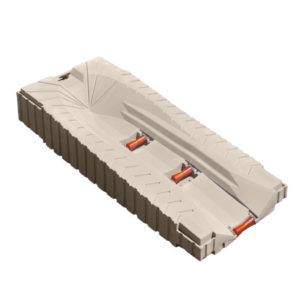
ShorePort PWC Lift by ShoreMaster
The ShorePort has a walkway on both sides for easy maintenance and access. ShorePorts are used wherever there is little wave action or where there is significant fluctuation in water depth. The ShorePort PWC lift can fluctuate an unlimited amount because it floats with the water level. Rising water levels in a river after a rainstorm presents no problem for the ShorePort.
Even kids can handle this one. If they can drive a Jet Ski, they can handle the ShorePort PWC Lift.
Is there another type of PWC lift available?
If you have a permanent pier or a concrete pier you could use a “Swinger” or “Tide Tamer” lift. The lift must be mounted to the side of a permanent structure. They raise the jet ski vertically.
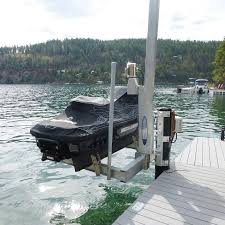
Swinger Pier Mounted Lift
The unique feature about this lift is that you have the ability to “swing” the entire jet ski over the top of the pier for storage, refueling or maintenance with little effort. Thus the name.
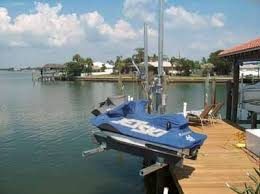
Swinger PWC Jet Ski Lift
This style of lift cannot be attached to any portable pier or dock.
Basic models come with a winch only, but most people will add a motor for ease of operation.
Single and Double units are available also.
Where can you find Pier & Waterfront Solutions?
We are located in the center of the Door County Peninsula at 7325 St. Hwy 42/57. That’s 1 mile North of County MM (Hwy 42) and 3 miles South of Sturgeon Bay. Look for the Idlewild Road intersection.
Our staff is always ready to serve your needs year round.
Don’t forget – Give us a call If you have a dock or boatlift topic you would like to see addressed on our site,
Call Jerry at 920-493-4404 or Email Jerry@wisconsinpws.com for more information.
Feb 13, 2018
Jet Ski Lifts
Jet Ski Lifts, in several different styles, are suitable for use in the waters of Door County. Each one has distinct applications depending on the body of water you use it on.
In this first of a 3 part series, we will discuss Vertical Jet Ski lifts. Part 2 will discuss the Jet Ski Docks and finally, Part 3 will discuss the permanent pier style Jet Ski Lifts.
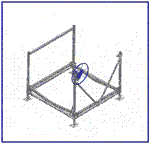
Vertical Lift in Action
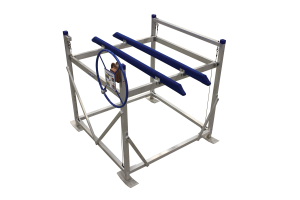
ShoreMaster Vertical PWC Lift
The most popular Jet Ski lift on the Bay of Green Bay –
ShoreMaster’s Vertical PWC Lift
ShoreMaster’s Vertical Jet Ski lifts feature:
- 1200# lifting capacity (capable of handling the new 3 seaters);
- 50″ lifting height;
- Welded side frames with braces (not bolted);
- Stainless steel lift cables; (not galvanized)
- Brass and Stainless Steel pulleys (not plastic); and
- All aluminum construction
It requires only 6″ of water plus the draft of your PWC to operate. The standard lift comes equipped with a hand crank winch.
What options are available for the Vertical Jet Ski Lifts?
- A solar-powered lift motor is available for complete ease of operation. A simple touch of the button will raise or lower your equipment without effort.
- An extended winch post can be added to raise the winch up to your dock height. The extension means you don’t have to bend down below the dock to crank the winch.
- Stainless steel PWC Loading platforms to make it easy to access your PWC and super easy to clean or service your unit.
- A choice of carpeted bunks, or better yet, the maintenance free vinyl clad bunks. You’ll never have torn carpeting again.
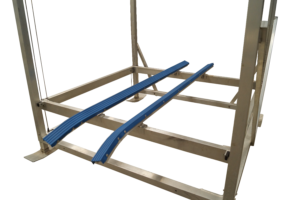
Vinyl Boat Bunks
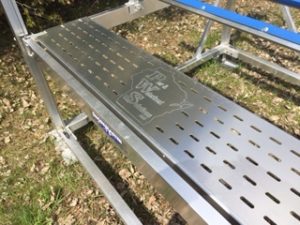
Jet Ski Lift Platforms
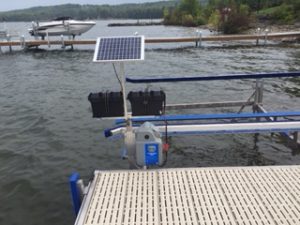
24 V Solar Panel arrangement
It’s the best vertical lift available. Used up & down the Bay of Green Bay – it’s the standard for PWC lifts.
Where can you find Pier & Waterfront Solutions?
We are located in the center of the Door County Peninsula at 7325 St Hwy 57. That’s just 1 mile North of County MM (Hwy 42) and 3 miles South of Sturgeon Bay. Look for the Idlewild Road intersection.
Our staff is always ready to serve your needs.
Give us a call If you have a dock or boat lift topic you would like to see addressed on our site,


























